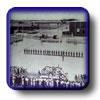Life on the Base
There were many different reasons people joined the Royal
Canadian Air Force (RCAF), the most obvious being that they
wanted to help with the war effort. Others were young,
looking for a career to pursue, and felt that the RCAF would be a decent employer. Whatever their reasoning, young
men, and later on young women, found themselves living
together on bases across the country. Most recruits were
youthful and excited to be part of the air force. They were
often posted to locales they had never experienced and
the bases had a spirit of adventure.
 In
Alberta, many of the bases were located in isolated areas
and while the local communities interacted with the people
on the air force bases, there was not always a lot to do
once the day’s work was done. After arriving and settling
into the routine of their training regimen, recruits found
they had time to pursue other activities. In
Alberta, many of the bases were located in isolated areas
and while the local communities interacted with the people
on the air force bases, there was not always a lot to do
once the day’s work was done. After arriving and settling
into the routine of their training regimen, recruits found
they had time to pursue other activities.
Many of the same interests one had in civilian life came
into play on the base. Those who were socially active by
nature would join with others who were similarly disposed
and create entertainment. Sports teams were organized and
men played in leagues with teams from other bases. To mark
special occasions, if the base had room to accommodate,
celebratory dinners and dances were held, often including
people from the local community.
 In
1941, the RCAF opened a women’s division and shortly thereafter,
women began arriving on bases. Many of the men serving were
not used to working side by side with women and some were
skeptical. However, women were a talented addition to the
British Commonwealth Air Training Plan (BCATP) and most
men recognized this and treated them as such, learning to
cooperate with their co-workers regardless of sex. In
1941, the RCAF opened a women’s division and shortly thereafter,
women began arriving on bases. Many of the men serving were
not used to working side by side with women and some were
skeptical. However, women were a talented addition to the
British Commonwealth Air Training Plan (BCATP) and most
men recognized this and treated them as such, learning to
cooperate with their co-workers regardless of sex.
 Elementary Flying Training School
(EFTS) was completed in
one’s home country and thus, until
Service Flying Training School
(SFTS), Canadians were attending training with
other Canadians. Under the BCATP, recruits from Great Britain,
Australia and New Zealand were present at SFTS. Later on
in the war, when countries such as France, Poland and Norway
were defeated by the Germans, recruits from these countries
also came to Canada to be trained. While this arrangement
of men from a variety of countries was generally positive,
some students recall having to overcome difficulties based
on cultural differences. In most cases, however, men from
different cultures found common ground and enjoyed their
experiences together. Elementary Flying Training School
(EFTS) was completed in
one’s home country and thus, until
Service Flying Training School
(SFTS), Canadians were attending training with
other Canadians. Under the BCATP, recruits from Great Britain,
Australia and New Zealand were present at SFTS. Later on
in the war, when countries such as France, Poland and Norway
were defeated by the Germans, recruits from these countries
also came to Canada to be trained. While this arrangement
of men from a variety of countries was generally positive,
some students recall having to overcome difficulties based
on cultural differences. In most cases, however, men from
different cultures found common ground and enjoyed their
experiences together.


|
 Heritage Community Foundation Presents
Heritage Community Foundation Presents Heritage Community Foundation Presents
Heritage Community Foundation Presents